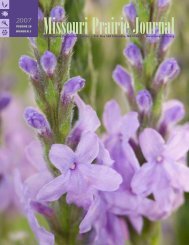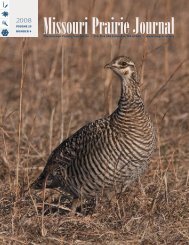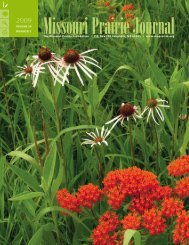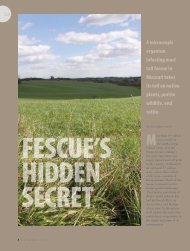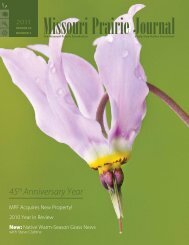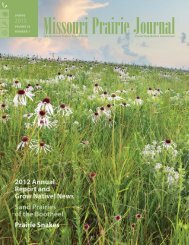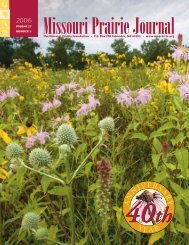Fall & Winter 2012: Volume 33, Numbers 3 & 4 - Missouri Prairie ...
Fall & Winter 2012: Volume 33, Numbers 3 & 4 - Missouri Prairie ...
Fall & Winter 2012: Volume 33, Numbers 3 & 4 - Missouri Prairie ...
You also want an ePaper? Increase the reach of your titles
YUMPU automatically turns print PDFs into web optimized ePapers that Google loves.
SCOTT WOODBURY<br />
Carol Davit<br />
SCOTT WOODBURY<br />
Clean edges, borders, and choosing the right plants for the landscaped space are all design elements and considerations that help create a positive<br />
perception of native landscapes.<br />
looking within a year. This easily<br />
accepted style blends in with the more<br />
traditional landscapes characteristic of<br />
many neighborhoods.<br />
Another approach is to create a<br />
planting that mimics a natural habitat,<br />
such as prairie, woodland, wetland,<br />
etc. This style, sometimes referred to as<br />
a “natural style,” is typically a seeded<br />
landscape. The design consists of outlining<br />
the area and compiling a list of<br />
plant species and ratios to be used in the<br />
seed mix. The area is prepared (existing<br />
vegetation removed/killed) in late summer<br />
to fall and seeding is done in early<br />
winter. This type of project takes three<br />
years to begin to mature—for two years<br />
the area is mowed high to keep weeds<br />
down and allow young seedlings to<br />
become established. “Wild” landscapes<br />
such as these are a contrast to many<br />
“tidy” landscapes and may raise concern<br />
with neighbors and weed ordinance<br />
officials. In this instance the cues play a<br />
key role—the wilder the look, the more<br />
important are the structural elements<br />
(paths, mowed areas, benches, etc.) and<br />
strong, clean borders (mowed grass strip,<br />
edging, etc.).<br />
The intermediate style can be fun<br />
and playful without causing concern<br />
amongst neighbors. In this instance,<br />
the design sets up a structural framework—strong<br />
lines, repetition of plant<br />
species, etc. Within this framework, the<br />
plantings can be more natural. Another<br />
method is to formalize the outer “public<br />
view” edge (along the road and sidewalk)<br />
with a more natural design inside.<br />
Right Plants, Right Place<br />
Where to begin? Settle on a design style.<br />
While your design may be environmentally<br />
friendly, your neighbors may not<br />
understand that aspect of it. Have a<br />
conversation with neighbors about your<br />
intentions and reasons for a more natural<br />
landscape.<br />
The next step is to put a layout<br />
of your property on paper. Include an<br />
assessment of conditions—sun versus<br />
shade, wet versus dry, and problem areas<br />
that need addressing such as erosion,<br />
need for screening, and replacing invasive<br />
species. Refer to native plant field<br />
guides and compare your situations to<br />
habitats where native plants naturally<br />
grow. Use the “right plant, right place”<br />
philosophy to ensure success. Double<br />
check plant cultural requirements at<br />
the nursery where you plan to purchase<br />
your plants and/or seeds. Consult the<br />
extensive native plant database at www.<br />
grownative.org. Landscaping with Native<br />
Plants: A Gardeners Guide for <strong>Missouri</strong>,<br />
a publication of Shaw Nature Reserve<br />
(www.shawnature.org), is an additional<br />
resource.<br />
Another major challenge with native<br />
landscapes is in the maintenance phase.<br />
Many great designs fall apart because of<br />
little or no maintenance. The first few<br />
years are particularly crucial as plants<br />
become established. This translates into<br />
a tendency for nature to foil our plans of<br />
a picturesque and bountiful landscape.<br />
Weeds take advantage of open spaces, so<br />
be vigilant. By year three, plant canopies<br />
should adequately cover the ground<br />
and out-compete weeds. Maintenance<br />
eases up, but still be watchful of weeds.<br />
Watering is essential in the first year to<br />
give young plants a healthy start. Once<br />
established, native plants require less irrigation<br />
than most non-native plants.<br />
Talk with other native plant gardeners<br />
and visit native plant gardens. Most<br />
importantly, start small and build on<br />
your successes.<br />
Horticulturist Cindy Gilberg owns Gilberg<br />
Design and Consulting, has worked in the<br />
Whitmire Wildflower Garden and Native<br />
Plant School at Shaw Nature Reserve for<br />
many years, and writes about native landscaping<br />
for several publications. Cindy’s<br />
article is made possible thanks to funding<br />
from Shaw Nature Reserve.<br />
Vol. <strong>33</strong> Nos. 3 & 4 <strong>Missouri</strong> <strong>Prairie</strong> Journal 23






